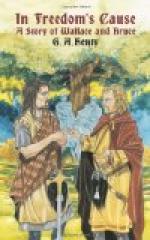The next spring Edward again advanced with an army even greater than that with which he had before entered Scotland. With him were Alexander of Baliol, son of the late king, who was devoted to the English; Dunbar, Fraser, Ross, and other Scottish nobles. The vast army first laid siege to the little castle of Carlaverock, which, although defended by but sixty men, resisted for some time the assaults of the whole army, but was at last captured. The Scots fell back as Edward advanced, renewing Wallace’s tactics of wasting the country, and Edward could get no further than Dumfries. Here, finding the enormous difficulties which beset him, he made a pretence of yielding with a good grace to the entreaties of the pope and the King of France that he would spare Scotland; he retired to England and disbanded his army, having accomplished nothing in the campaign save the capture of Carlaverock.
The following summer he again advanced with the army, this time supported by a fleet of seventy ships. The Scots resorted to their usual strategy, and, when winter came, the invaders had penetrated no further than the Forth. Edward remained at Linlithgow for a time, and then returned to England. Sir Simon Fraser, who had been one of the leaders of the English army at Carlaverock, now imitated Comyn’s example, and, deserting the English cause, joined his countrymen.
The greater part of the English army recrossed the Border, and the Scots captured many of the garrisons left in the towns. Sir John Seagrave next invaded Scotland with from 20,000 to 30,000 men, mostly cavalry. They reached the neighbourhood of Edinburgh, when Comyn and Fraser advanced against them with 8000 men, chiefly infantry. The English army were advancing in three divisions, in order better to obtain provisions and forage. After a rapid night march the Scotch came upon one of them, commanded by Seagrave in person; and conceiving himself sufficiently strong to defeat the Scots unaided by any of the other divisions, Sir John Seagrave immediately gave battle.
As at Falkirk, the English cavalry were unable to break through the Scottish pikes. Great numbers were killed or taken prisoners, Seagrave himself being severely wounded and captured, with twenty distinguished knights, thirty esquires, and many soldiers. Scarcely was the battle over when the second English division, even stronger than the first, arrived on the field. Encumbered by their prisoners, the Scots were at a disadvantage; and fearing to be attacked by these in the rear while engaged in front, they slaughtered the greater portion of the prisoners, and arming the camp followers, prepared to resist the English onslaught. This failed as the first had done; the cavalry were defeated with great loss by the spearmen, and many prisoners taken — among them Sir Ralph Manton.




